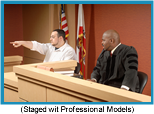Victim Media Advocacy:
How to Facilitate Sensitive and Respectful Treatment of Crime Victims

PAGE INDEX
a. Intrusion
b. Cameras in the Courtroom
c. Private Facts
d. False Light

The history of constitutional law in the United States is the story of balancing one right against another, in this case the public’s right to know versus the victim’s right to privacy. On one side are members of the press who want unfettered access to public information and the ultimate authority to decide what to print. On the other side are crime victims, typically private citizens thrust into the media’s glare, struggling to maintain privacy. A patchwork of federal and state laws and court decisions at various levels illuminate ways the pendulum has swung over the years.
The public’s right to know derives from the constitutional right to a free press enshrined in the First Amendment. For many years, the U.S. Congress and the courts favored expanding reporters’ rights. The Freedom of Information Act of 1966 (FOIA) resulted in so-called “sunshine laws” in all 50 states, designed to enhance public access to government records and meetings. The Society for Professional Journalists provides information and advice to reporters on filing FOIA requests to gain access to public records. Court decisions have generally supported that anything open to the public can be reported by the news media.
However, access to information about crime and crime victims also depends on how local law enforcement agencies interpret their responsibility to share such information. Each of this country’s roughly 17,500 local law enforcement agencies can make independent decisions about what should be shared and what should be kept secret as part of an ongoing investigation. As most criminal justice journalists will attest, there is almost always constant negotiation between local news organizations and the police about access to information about crimes and crime victims.
Despite the tensions, conflicts between reporters, law enforcement, and the courts are usually resolved informally, though some result in litigation. Various groups, including victim advocacy organizations, can promote legislation to codify or change current practices and those cases can end up tested in court.
In recent years, the pendulum appears to have swung in favor of greater protection of personal privacy. Passage of the USA PATRIOT Act, the impact of 9/11, and concerns about the Internet’s intrusion into our lives have created a climate in favor of reducing access to information that reporters have previously enjoyed.
 An individual’s right to privacy is not explicitly addressed in the Bill of Rights. However, since the late 19th century, a growing body of constitutional law finds a right to privacy in various aspects of the first, fourth, fifth, and ninth amendments. The four basic areas that the emerging body of privacy law covers include—
An individual’s right to privacy is not explicitly addressed in the Bill of Rights. However, since the late 19th century, a growing body of constitutional law finds a right to privacy in various aspects of the first, fourth, fifth, and ninth amendments. The four basic areas that the emerging body of privacy law covers include—
- Appropriation of name or likenesses for trade purposes.
- Intrusion on an individual’s solitude.
- Publication of private information about an individual.
- Publishing information that puts an individual in a false light.10 10. Don R. Pember, 2002, Mass Media Law, 2003/2004 Edition, New York: McGraw-Hill Companies.
The first issue is more likely to come into play for crime victims when entertainment media, rather than news media, seek to portray what happened to them. While it can be argued that the story of what happened to a crime victim is in the public domain, media companies often offer to pay victims or their families when they want to do a “docudrama,” to preclude the possibility of litigation. The succeeding three areas have obvious implications for reporting on crime and crime victims:
- a. Intrusion. According to the Reporters Committee for Freedom of the Press, journalists can be found to intrude on a person’s right to solitude when they gather information, regardless of whether the information is later published or not. Court cases involving trespass, hidden surveillance, and fraudulent entry generally support the idea that private citizens enjoy a zone of privacy, especially at home.11 11. Photographers’ Guide to Privacy, “A primer on invasion of privacy,” The Reporters Committee for Freedom of the Press, http://www.rcfp.org/pullouts/photographers/index.php?pg=primer
, accessed March 30, 2007 and “9 Keys to Avoiding Invasion of Privacy Suits,” http://www.rcfp.org/pullouts/photographers/index.php?pg=9keys, accessed March 30, 2007.
(See bottom of page to activate links.)Reporters can stand outside a person’s home as long as they stay on public sidewalks and roadways.
 It may be considered harassment, however, if reporters ring the doorbell or telephone too often. In Gallela v. Onassis in 1973, the U.S. Supreme Court decided that freelance photographer Ron Gallela could not pursue Jackie Kennedy Onassis into private places. He was also ordered to stay at least 25 feet away from her and at least 30 feet away from her children. Gallela had argued that Onassis was a public figure who therefore enjoyed fewer rights to privacy than a private citizen, but the U.S. Supreme Court viewed his actions as tantamount to harassment.12 12. Pember, pp. 259, 290
It may be considered harassment, however, if reporters ring the doorbell or telephone too often. In Gallela v. Onassis in 1973, the U.S. Supreme Court decided that freelance photographer Ron Gallela could not pursue Jackie Kennedy Onassis into private places. He was also ordered to stay at least 25 feet away from her and at least 30 feet away from her children. Gallela had argued that Onassis was a public figure who therefore enjoyed fewer rights to privacy than a private citizen, but the U.S. Supreme Court viewed his actions as tantamount to harassment.12 12. Pember, pp. 259, 290
In terms of technological intrusion, a number of states have laws that prevent people from recording telephone calls without the permission of the other party. The courts have also told reporters that they cannot use electronic eavesdropping devices to gather information.
In 1999, in Wilson v. Layne, the U.S. Supreme Court ruled that police agencies should not allow reporters on “ride-alongs” to follow police into private residences, which has implications for victims and witnesses.13 13. Pember, p. 302
The general test for still and moving images is that photographers and videographers do not need permission in places people have no expectation of privacy, which means people on public thoroughfares are therefore “fair game.” It should be noted that schools are public places paid for by tax dollars, but courts allow them special privileges in denying access to reporters. News media, however, should obscure the faces or other identifiers of people used in stock photos or file footage that portrays them in an unflattering light.
 Numerous state court cases have decided that photographers and videographers cannot use telephoto lenses to intrude visually into private spaces, even though they are not intruding themselves. People in their own homes enjoy an expectation of privacy, so shooting photos of them through a window constitutes a violation of their personal privacy, even if the photographer or videographer is standing on public property.
Numerous state court cases have decided that photographers and videographers cannot use telephoto lenses to intrude visually into private spaces, even though they are not intruding themselves. People in their own homes enjoy an expectation of privacy, so shooting photos of them through a window constitutes a violation of their personal privacy, even if the photographer or videographer is standing on public property.
Many states have laws that prevent a person (including reporters) from taping telephone conversations without the permission of all parties. Courts have also generally decided that reporters cannot use hidden cameras or tape recorders except in limited cases where investigative reporting serves a greater good. Ethically and legally, reporters should identify themselves as such when they approach crime victims. Again, there may be cases where investigative reporters can mislead people about their intentions, but even these instances have narrowed over the years.
- b. Cameras in the courtroom. Today, most states allow cameras in the courtroom (which technically incorporates televising, recording, and taking photographs). The exception is in federal courts and the U.S. Supreme Court where cameras are not allowed. Victims’ concerns for privacy can be taken into consideration even if cameras are allowed. Prosecutors and victim service providers can present any concerns to the court that protect a victim’s privacy (for example, in cases involving people in witness protection programs) and safety (if showing a victim/witness’s image will place them at risk for threats, intimidation, or harm).
 Many state court organizations have developed operating rules that guide the use of cameras in the courtroom. While not binding, they address issues such as—
Many state court organizations have developed operating rules that guide the use of cameras in the courtroom. While not binding, they address issues such as—
- When media coverage is allowed or prohibited.
- Court personnel responsible for coordinating media coverage and cameras in the courtroom.
- Accommodations for media personnel and equipment.
An example of guidelines for cameras in the courtroom, published by the Supreme Court of Missouri, can be accessed at http://www.courts.mo.gov/page.jsp?id=690.
c. Private facts. Information that is part of a public record is generally considered open to the press to report. A landmark 1975 U.S. Supreme Court case that still resonates today is Cox Broadcasting Corp. v. Cohn, where an Atlanta television station reported the name of a 17-year-old girl who was raped and murdered, violating a Georgia statute that made reporting the name of a rape victim illegal. The U.S. Supreme Court decided that the Georgia law violated the Constitution. Among the reasons the justices cited for the majority decision was that reporters should not be prevented from reporting information already in the public record.14 14. Pember, pp. 205, 270–271–, 280.
In a similar 1989 case (Florida Star v. B.J.F.), the U.S. Supreme Court reversed an appellate court that awarded a rape victim $100,000 when a rookie reporter published her name, in violation of the news organization’s policies. (The local sheriff’s office had published the name in a news release, while asking reporters not to use it.) The U.S. Supreme Court decision stated that news media have the right to publish public information.15 15. Pember, pp. 205, 291.
 On the other hand, Florida court challenges involving whether the Orlando-Sentinel could gain access to autopsy photographs of NASCAR driver Dale Earnhardt denied news organizations the right to do so. As is often the case, legislators responded to the controversy by passing the Earnhardt Family Protection Act, to prevent news organizations from securing autopsy photos. A subsequent attempt by a student publication to secure the photos, arguing the law was being applied retroactively to the Earnhardt photos, failed when the Florida court decided that the press had no inherent right to them.16 16. Roger C. Roy, and Amy C. Rippel, “Earnhardts win right to keep autopsy photos sealed,” Orlando-Sentinel, http://www.orlandosentinel.com/sports/motorracing/sns-earnhardt-autopsyphotos,0,4354798.story, accessed March 30, 2007 and “Fla. college paper appeals Earnhardt autopsy photo case to the Supreme Court, Student Press Law Center, http://www.splc.org/newsflash.asp?id=677, accessed March 30, 2007.
On the other hand, Florida court challenges involving whether the Orlando-Sentinel could gain access to autopsy photographs of NASCAR driver Dale Earnhardt denied news organizations the right to do so. As is often the case, legislators responded to the controversy by passing the Earnhardt Family Protection Act, to prevent news organizations from securing autopsy photos. A subsequent attempt by a student publication to secure the photos, arguing the law was being applied retroactively to the Earnhardt photos, failed when the Florida court decided that the press had no inherent right to them.16 16. Roger C. Roy, and Amy C. Rippel, “Earnhardts win right to keep autopsy photos sealed,” Orlando-Sentinel, http://www.orlandosentinel.com/sports/motorracing/sns-earnhardt-autopsyphotos,0,4354798.story, accessed March 30, 2007 and “Fla. college paper appeals Earnhardt autopsy photo case to the Supreme Court, Student Press Law Center, http://www.splc.org/newsflash.asp?id=677, accessed March 30, 2007.
(See bottom of page to activate links.)
In contrast, the courts have generally supported that news organizations can publish information they uncover about people that is not necessarily germane to the crime. In 1984, a California appellate court decided in Sipple v. Chronicle Publishing that the San Francisco Chronicle had the right to publish that Oliver Sipple was a homosexual. Sipple argued that publishing this information was an intrusion on his privacy. A lower court found in his favor and awarded damages. The Chronicle reported his sexual orientation as part of its story about how he deflected the gun that Manson family member Sara Jane Moore wielded in her attempt to assassinate President Gerald R. Ford. The California appellate court determined that Sipple’s sexual orientation was newsworthy because he participated in gay activism and because his heroism might dispel the idea that homosexuals are “timid, weak, or unheroic.”17 17. Pember, p. 179, 268.
- d. False light. Portraying a person in a false light is not necessarily actionable. The test is whether the news organization knew the information was false (and exercised its responsibility to determine the facts) and then recklessly or maliciously published the information anyhow.
A U.S. Supreme Court case that helped set the standard was Time, Inc., v. Hill in 1967. In a six-to-three decision, the High Court found that Time, Inc., could not be held liable even though the information published was untrue. The case stemmed from an incident in 1952, when three escaped convicts took James Hill, his wife, and their five children hostage, releasing all of them unharmed hours later. The following year, an author published a novel based on the case that was later made into a play. Life magazine (owned by Time, Inc.) later repeated information from the play about the family that was not true. Lower courts found in favor of the family, but the U.S. Supreme Court established the standard that, to be held liable, a news organization has to display malicious intent.

Most news organizations use sensitivity when dealing with crime victims, while serving the public by providing them the information they need about crime and victimization. It serves all parties when disputes can be handled without litigation. As we see with the laws regarding disclosing the names of victims of rape and sexual assault, a news organization may win the case in court but lose the case in the court of pubic opinion.
11. Photographers’ Guide to Privacy, “A primer on invasion of privacy,” The Reporters Committee for Freedom of the Press,http://www.rcfp.org/pullouts/photographers/index.php?pg=primer, accessed March 30, 2007 and “9 Keys to Avoiding Invasion of Privacy Suits,” http://www.rcfp.org/pullouts/photographers/index.php?pg=9keys, accessed March 30, 2007.
16. Roger C. Roy, and Amy C. Rippel, “Earnhardts win right to keep autopsy photos sealed,” Orlando-Sentinel, http://www.orlandosentinel.com/sports/motorracing/sns-earnhardt-autopsyphotos,0,4354798.story, accessed March 30, 2007 and “Fla. college paper appeals Earnhardt autopsy photo case to the Supreme Court, Student Press Law Center, http://www.splc.org/newsflash.asp?id=677, accessed March 30, 2007.




